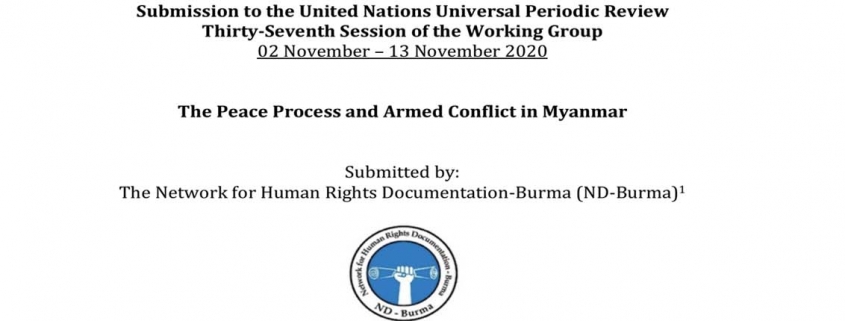Submission to the United Nations Universal Periodic Review Thirty-Seventh Session of the Working Group
Executive Summary
This submission by the Network for Human Rights Documentation Burma (ND-Burma) addresses the peace process and armed conflict in Myanmar. Using case-studies from our reports and briefing papers with documentation supported by our members, the sections provide situational context to the security concerns expressed by civilians and civil-society.
The human rights situation in Myanmar has deteriorated under the current quasi-civilian government 2 led by the National League for Democracy (NLD). State Counsellor, Daw Aung San Suu Kyi maintains favorable status among the Bamar majority, though ethnic civilians have distanced their loyalty as she has stood by the military against the backdrop of violations.
The Nationwide Ceasefire Agreement (NCA) has been signed by ten ethnic armed organizations (EAOs). It was agreed upon by the majority of the parties in 2015, with the process being initiated by the former military government in 2011. Despite the intentions of the NCA to halt military operations between the Myanmar Army and EAOs, clashes continue.
Approximately 21 EAOs have been engaged in the NCA process through formal and informal capacities. The EAOs who have decided to not participate chose to become affiliated with the 16-member National Ceasefire Coordination Team, which was established in 2013 and is considered the main organization in peace negotiations with the government. When the NLD took the office, they established National Reconciliation and Peace Center (NRPC) and Union Peace Dialogue Joint Committee, which is under the NRPC and includes government, parliament, the Myanmar Army, EAOs (signatories) and representatives from successful parties in the election.
It has become clear that despite the declaration of unilateral ceasefires agreements in conflict-affected northern Myanmar, these commitments are not sincere as the Myanmar Army continues to wage war.
According to ND-Burma’s documentation, the main human rights abuses civilians suffered from were indiscriminate gunfire, shelling and aerial bombardments, torture leading to deaths and injuries; extrajudicial killings; injuries and deaths due to landmines; inhumane and degrading treatment; arbitrary arrest, detention, forced disappearance; rape and sexual violence.
Our submission concludes that the Myanmar Army continues to use strategic military tactics designed to intimidate and isolate villagers to prolong the civil war, rather than seek peaceful alternatives to conflict.




